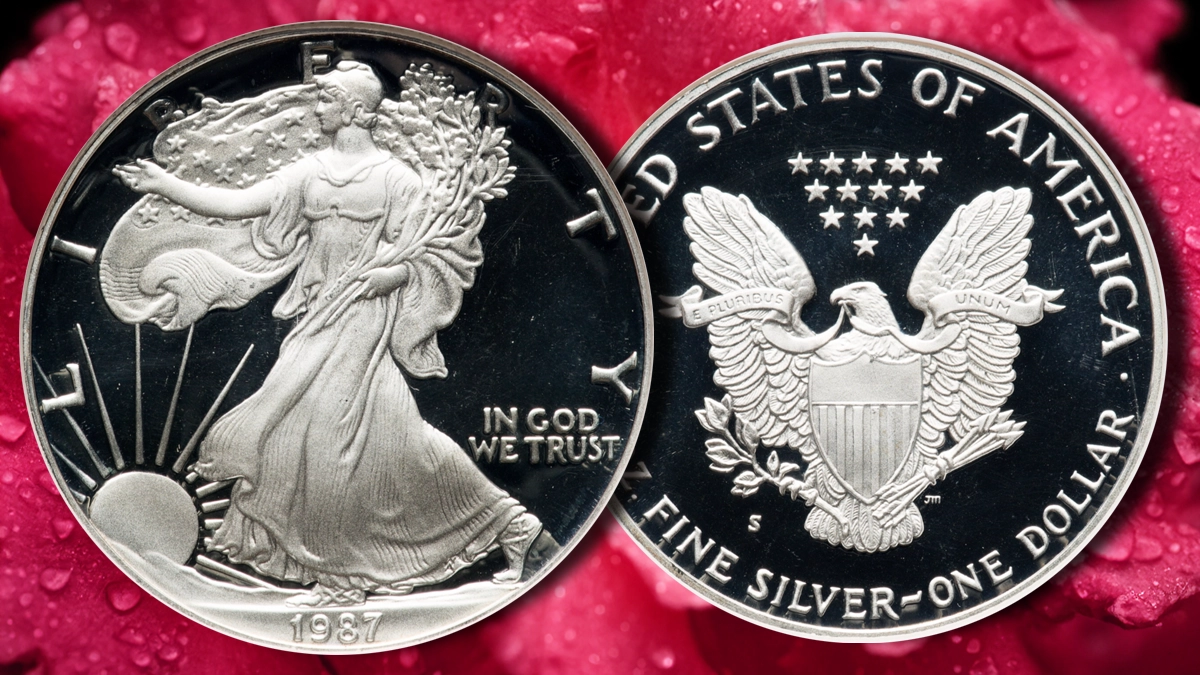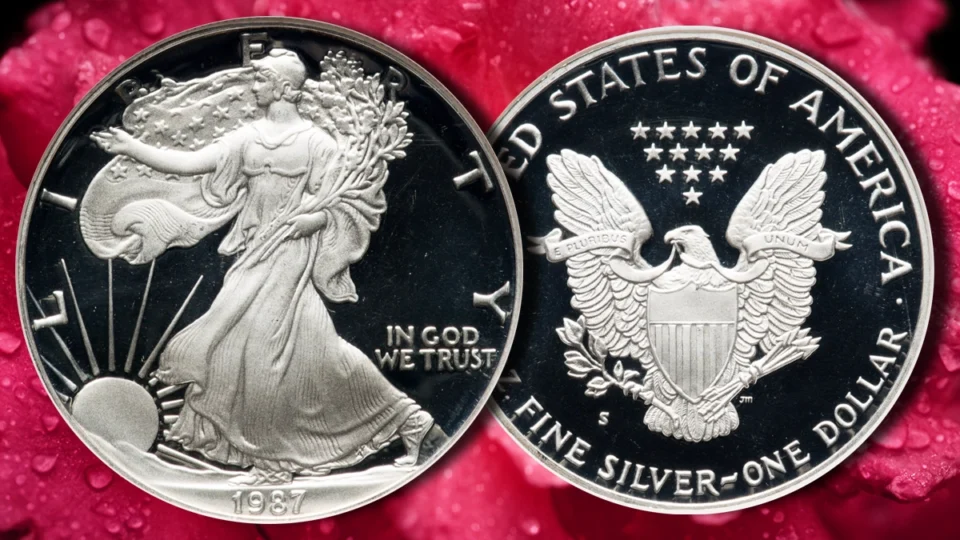
1987 was the second year of the American Silver Eagle coin program and the first full year of coin production.
While the bullion coin set a new benchmark in sales, sales of the 1987-S American Silver Eagle Proof were well off the pace set in the issue’s debut year. Some have ascribed the decline in the Mint’s decision to raise the coin’s price by $2.00, but it is more likely that the buzz for the new coin program had subsided somewhat in 1987. Adjusted for inflation, the issue price of the 1987-S was $63.79 in 2024 dollars.
The San Francisco Mint struck this issue at a high standard, with the typical pieces exhibiting thick white frost on the devices and a deeply-mirrored field. Properly stored examples should retain this look, but it is not uncommon to find examples with hazy fields and tarnished frost. There is no reason to settle for coins with these attributes.
The American Silver Eagle is a beautiful coin with a classic design. The coin’s obverse features a reworked version of Adolph Weinman’s Walking Liberty half-dollar obverse, while the reverse features a balanced and stately heraldic eagle design by John Mercanti.
What Is the 1987-S American Silver Eagle Proof Coin Worth?
In the past ten years, the certified population of the 1987-S American Silver Eagle has risen from 3.98% to its current level of 6.5%. This increase is unsurprising as the American Silver Eagle is a firmly rooted collectible coin with a growing collector base. What is surprising is what the numbers tell us about the certification rates of 69 and 70 coins.
When we last pulled data on the series in 2014, PCGS reported a population of 11,772 PR69DCAM coins against a population of 1,401 PR70DCAM coins for a ratio of 8.4:1.
In the intervening years since, the PCGS population has increased to 19,609 PR69DCAMs and 4,403 PR70DCAMs, with a ratio of 2.6:1 for all coins graded from 2014-2024.
The NGC population data illustrates an even more dramatic shift in the percentages of coins earning the “perfect” Proof 70 grade. In 2014, NGC reported a population of 21,138 PF69UCAMs against just 572 PF70UCAMs. The ratio of 69s to 70s in this dataset was 36.95:1. Since 2014, NGC has graded 8,912 new 69s and 2,245 new 70s. For NGC, this is a 3.97:1 clip.
CAC, having only recently entered the modern coin grading business, has certified only three coins—all graded PR70DCAM.
Have these increased Proof 70 grading rates at PCGS and NGC impacted price levels for the 1987-S American Silver Eagles? The answer for 69s is no. Even adjusting for a weaker dollar in 2024, the typical price for a 69 1987-S Silver Eagle is between $10 and $15 higher today than ten years ago.
Unfortunately, those who invested in Proof 70s cannot say the same. Ten years ago, one would expect to pay between $450 and $525 for a PCGS-graded example. For an NGC coin, the cost was even higher, at $680 to $720. Adjusted for inflation, these prices equal $593 to $692 in 2024 for a PCGS 70 and $896 to $949 for an NGC 70.
A survey of 2023 and early 2024 sales data from GreatCollections and eBay show prices for PCGS 70s as low as $170 for PCGS coins and $280 for NGC coins, with an average of $300 to $400, respectively. Collectors are paying a premium for coins in holders with signature label inserts and discounting coins in older holders.
Design
Obverse:
Sculptor Adolph A. Weinman’s Lady Liberty is depicted mid-stride. She is seen as a full-body figure, dressed in a flowing gown, and draped with a large billowing American flag. She holds laurel and oak branches in her left hand that symbolize the civil and military glories of America, respectively. As Liberty strides confidently towards the rising sun, she also reaches out and presents a welcoming and open hand. So large is Lady Liberty that she is superimposed over the obverse legend LIBERTY ringing the obverse – in fact, she obscures half of the “BE” and almost the entire “R”. Above Liberty’s outstretched rear foot is IN GOD WE TRUST, and below her is the date (1987).
The design bears a notable resemblance to sculptor Oscar Roty’s The Sower, a common image on French coins. Numismatist Roger Burdette posited in his book Renaissance of American Coinage (2007) that this was not a coincidence and while Adolph Weinman did not directly copy, he did derive significant inspiration from Roty’s work. Weinman’s Liberty Walking design quickly became one of America’s most iconic numismatic images and would be used with minor modifications on the American Silver Eagle bullion coin starting in 1986.
Reverse:
United States Mint Chief Engraver John M. Mercanti’s Heraldic Eagle is positioned at the center of the reverse. Clutched in its beak is a ribbon that bears the motto E PLURIBUS UNUM. Above its head, is a constellation of 13 stars configured in an upside-down pyramid formation. Wrapping around the design is the legend (top) UNITED STATES OF AMERICA and the fineness and denomination (bottom) 1 OZ. FINE SILVER. ONE DOLLAR. Below the olive branch is the S mintmark of San Francisco.
Edge:
The edge of the 1987 American Silver Eagle Proof coin is reeded.
* * *
Coin Specifications
| American Silver Eagle Proof Coin | |
| Year Of Issue: | 1987 |
| Denomination: | One Dollar (USD) |
| Mint Mark: | S (San Francisco) |
| Mintage: | 904,732 |
| Alloy: | 99.9% silver |
| Weight: | 31.1 g |
| Diameter: | 40.6 mm |
| Edge: | Reeded |
| OBV Designer | Adolph A. Weinman |
| REV Designer | John M. Mercanti |
* * *

